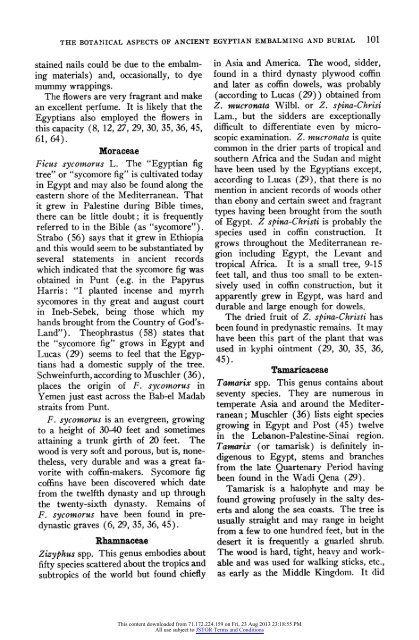The Botanical Aspects of Ancient Egyptian Embalming and Burial
The Botanical Aspects of Ancient Egyptian Embalming and Burial
The Botanical Aspects of Ancient Egyptian Embalming and Burial
You also want an ePaper? Increase the reach of your titles
YUMPU automatically turns print PDFs into web optimized ePapers that Google loves.
THE BOTANICAL ASPECTS OF ANCIENT EGYPTIAN EMBALMING AND BURIAL 101<br />
stained nails could be due to the embalming<br />
materials) <strong>and</strong>, occasionally, to dye<br />
mummy wrappings.<br />
<strong>The</strong> flowers are very fragrant <strong>and</strong> make<br />
an excellent perfume. It is likely that the<br />
<strong>Egyptian</strong>s also employed the flowers in<br />
this capacity (8, 12, 27, 29, 30, 35, 36, 45,<br />
61, 64).<br />
Moraceae<br />
Ficus sycomorus L. <strong>The</strong> "<strong>Egyptian</strong> fig<br />
tree" or "sycomore fig" is cultivated today<br />
in Egypt <strong>and</strong> may also be found along the<br />
eastern shore <strong>of</strong> the Mediterranean. That<br />
it grew in Palestine during Bible times,<br />
there can be little doubt; it is frequently<br />
referred to in the Bible (as "sycomore").<br />
Strabo (56) says that it grew in Ethiopia<br />
<strong>and</strong> this would seem to be substantiated by<br />
several statements in ancient records<br />
which indicated that the sycomore fig was<br />
obtained in Punt (e.g. in the Papyrus<br />
Harris: "I planted incense <strong>and</strong> myrrh<br />
sycomores in thy great <strong>and</strong> august court<br />
in Ineb-Sebek, being those which my<br />
h<strong>and</strong>s brought from the Country <strong>of</strong> God's-<br />
L<strong>and</strong>"). <strong>The</strong>ophrastus (58) states that<br />
the "sycomore fig" grows in Egypt <strong>and</strong><br />
Lucas (29) seems to feel that the <strong>Egyptian</strong>s<br />
had a domestic supply <strong>of</strong> the tree.<br />
Schweinfurth, according to Muschler (36),<br />
places the origin <strong>of</strong> F. sycomorus in<br />
Yemen just east across the Bab-el Madab<br />
straits from Punt.<br />
F. sycomorus is an evergreen, growing<br />
to a height <strong>of</strong> 30-40 feet <strong>and</strong> sometimes<br />
attaining a trunk girth <strong>of</strong> 20 feet. <strong>The</strong><br />
wood is very s<strong>of</strong>t <strong>and</strong> porous, but is, nonetheless,<br />
very durable <strong>and</strong> was a great favorite<br />
with c<strong>of</strong>fin-makers. Sycomore fig<br />
c<strong>of</strong>fins have been discovered which date<br />
from the twelfth dynasty <strong>and</strong> up through<br />
the twenty-sixth dynasty. Remains <strong>of</strong><br />
F. sycomorus have been found in predynastic<br />
graves (6, 29, 35, 36, 45).<br />
Rhamnaceae<br />
Zizyphus spp. This genus embodies about<br />
fifty species scattered about the tropics <strong>and</strong><br />
subtropics <strong>of</strong> the world but found chiefly<br />
in Asia <strong>and</strong> America. <strong>The</strong> wood, sidder,<br />
found in a third dynasty plywood c<strong>of</strong>fin<br />
<strong>and</strong> later as c<strong>of</strong>fin dowels, was probably<br />
(according to Lucas (29) ) obtained from<br />
Z. mucronata Wilbl. or Z. spina-Chrisi<br />
Lam., but the sidders are exceptionally<br />
difficult to differentiate even by microscopic<br />
examination. Z. mucronata is quite<br />
common in the drier parts <strong>of</strong> tropical <strong>and</strong><br />
southern Africa <strong>and</strong> the Sudan <strong>and</strong> might<br />
have been used by the <strong>Egyptian</strong>s except,<br />
according to Lucas (29), that there is no<br />
mention in ancient records <strong>of</strong> woods other<br />
than ebony <strong>and</strong> certain sweet <strong>and</strong> fragrant<br />
types having been brought from the south<br />
<strong>of</strong> Egypt. Z spina-Christi is probably the<br />
species used in c<strong>of</strong>fin construction. It<br />
grows throughout the Mediterranean region<br />
including Egypt, the Levant <strong>and</strong><br />
tropical Africa. It is a small tree, 9-15<br />
feet tall, <strong>and</strong> thus too small to be extensively<br />
used in c<strong>of</strong>fin construction, but it<br />
apparently grew in Egypt, was hard <strong>and</strong><br />
durable <strong>and</strong> large enough for dowels.<br />
<strong>The</strong> dried fruit <strong>of</strong> Z. spina-Christi has<br />
been found in predynastic remains. It may<br />
have been this part <strong>of</strong> the plant that was<br />
used in kyphi ointment (29, 30, 35, 36,<br />
45).<br />
Tamaricaceae<br />
Tamarix spp. This genus contains about<br />
seventy species. <strong>The</strong>y are numerous in<br />
temperate Asia <strong>and</strong> around the Mediterranean;<br />
Muschler (36) lists eight species<br />
growing in Egypt <strong>and</strong> Post (45) twelve<br />
in the Lebanon-Palestine-Sinai region.<br />
Tamarix (or tamarisk) is definitely indigenous<br />
to Egypt, stems <strong>and</strong> branches<br />
from the late Quartenary Period having<br />
been found in the Wadi Qena (29).<br />
Tamarisk is a halophyte <strong>and</strong> may be<br />
found growing pr<strong>of</strong>usely in the salty deserts<br />
<strong>and</strong> along the sea coasts. <strong>The</strong> tree is<br />
usually straight <strong>and</strong> may range in height<br />
from a few to one hundred feet, but in the<br />
desert it is frequently a gnarled shrub.<br />
<strong>The</strong> wood is hard, tight, heavy <strong>and</strong> workable<br />
<strong>and</strong> was used for walking sticks, etc.,<br />
as early as the Middle Kingdom. It did<br />
This content downloaded from 71.172.224.159 on Fri, 23 Aug 2013 23:18:55 PM<br />
All use subject to JSTOR Terms <strong>and</strong> Conditions
















